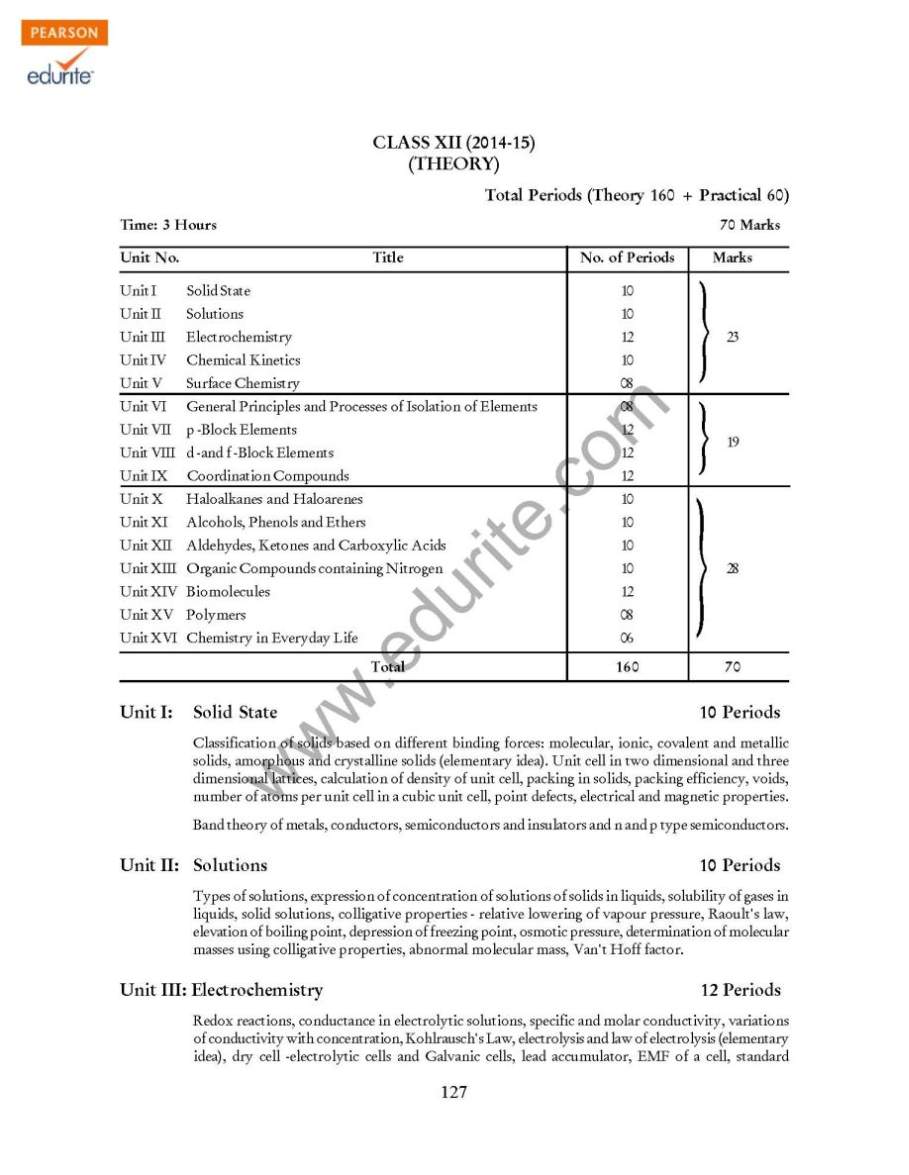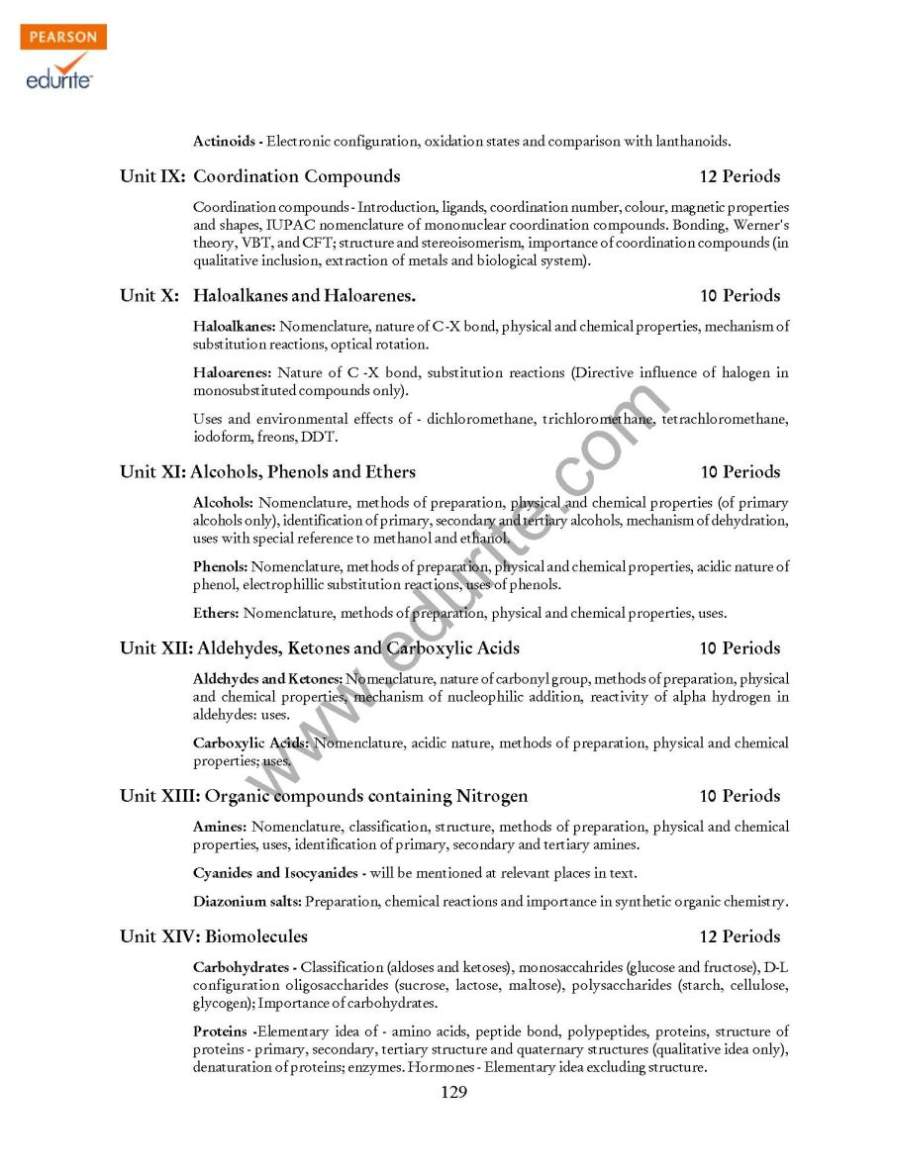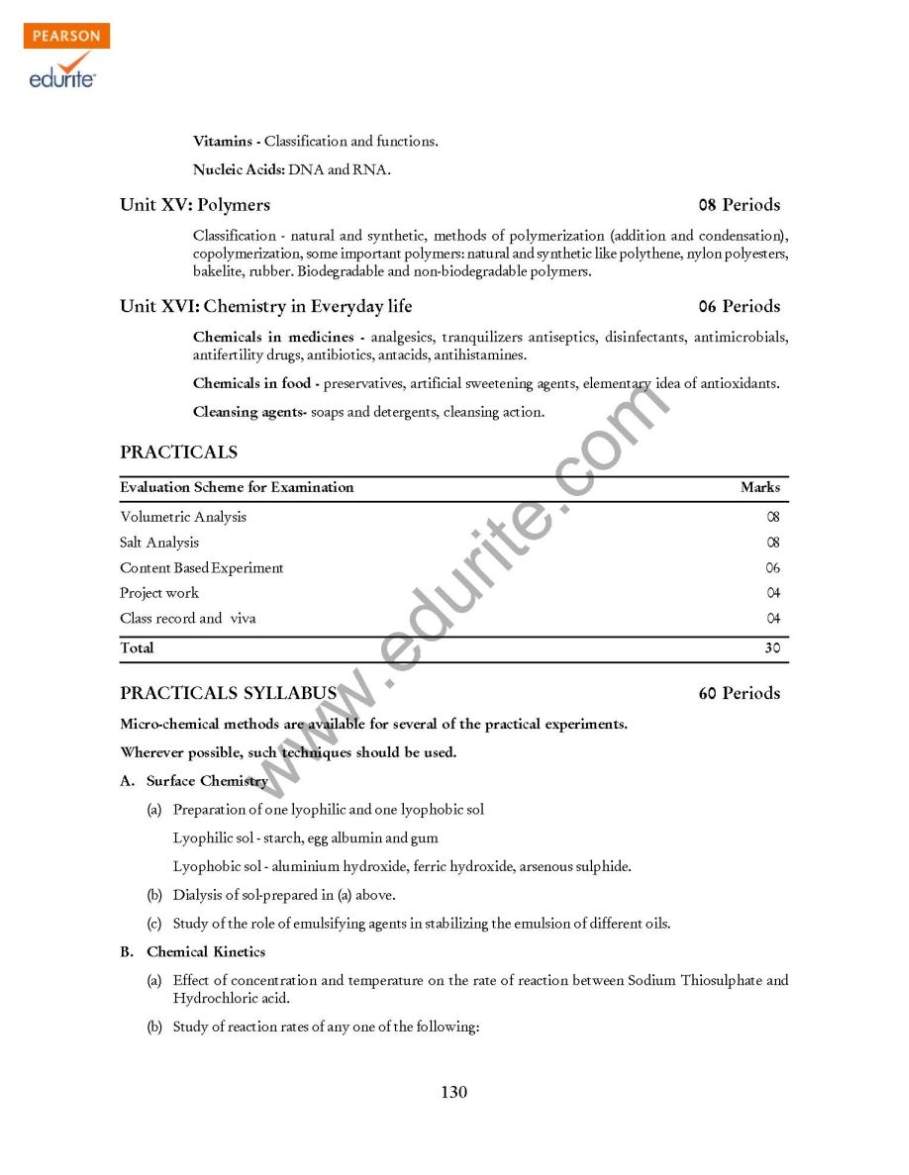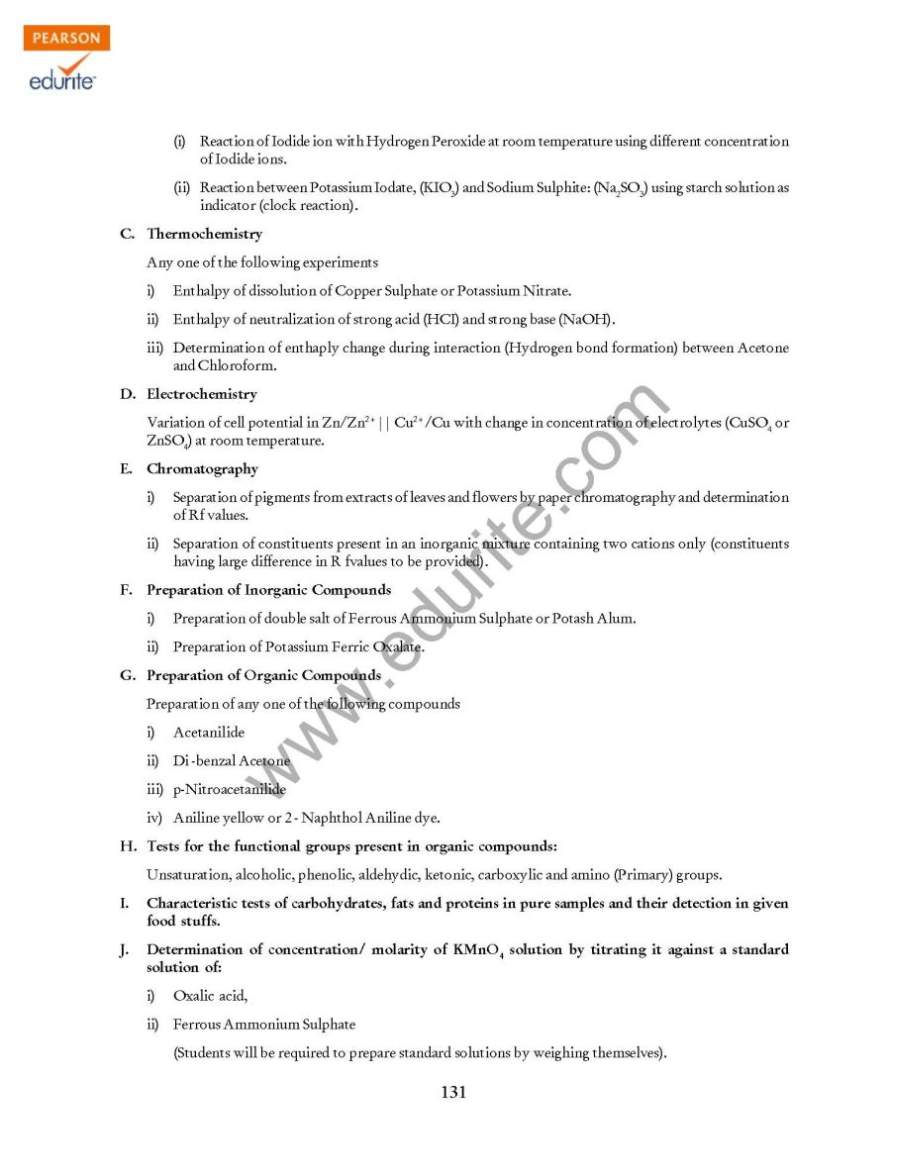| Re: Excluded portions of Chemistry for CBSE class 12 exam
You are asking for the Excluded portions of Chemistry for CBSE class 12 exams. In generals you should need to learn all the topics. Here I am providing you the CBSE class 12 Chemistry syllabus after removing the Excluded portions. You can follow this syllabus.
CBSE class 12 Chemistry syllabus
CHAPTER 1 - : Solid State
Classification of solids based on different binding forces:
molecular, ionic, covalent and metallic solids,
amorphous and crystalline solids (elementary idea),
Crystal Lattices and unit cells,
calculation of density of unit cell,
packing in solids,voids,
number of atoms per unit cell in a cubic unit cell,
point defects, electrical and magnetic properties.
CHAPTER 2 - Solutions
Types of solutions,
expression of concentration of solutions of solids in liquids,
solubility of gases in liquids,
solid solutions,
colligative properties – relative lowering of vapour pressure,
elevation of boiling point,
depression of freezing point,
osmotic pressure,
determination of molecular masses using colligative properties,
abnormal molecular mass.
CHAPTER 3 - Electrochemistry
Redox reactions,
conductance in electrolytic solutions,
specific and molar conductivity,
variations of conductivity with concentration,
Kohlrausch’s Law,
electrolysis and law of electrolysis (elementary idea),
dry cell -electrolytic cells and Galvanic cells,
lead accumulator,
EMF of a cell,
standard electrode potential,
Nernst equation and its application to chemical cells,
fuel cells
CHAPTER 4 - Chemical Kinetics
Rate of a reaction (Average and instantaneous),
factors affecting rate of reaction: concentration, temperature, catalyst order and molecularity of a reaction, rate law and specific rate constant,
integrated rate equation and half life (only for zero and first order reactions),
collision theory (elementary idea, no mathematical treatment).
CHAPTER 5 - Surface Chemistry
Adsorption – physisorption and chemisorption,
factors affecting adsorption of gases on solids,
colloids distinction between true solutions,
colloids and suspension; lyophilic , lyophobic multimolecular and macromolecular colloids;
properties of colloids; Tyndall effect,
Brownian movement, electrophoresis, coagulation,
emulsion – types of emulsions
CHAPTER 6 - General Principles and Processes of Isolation of Elements
Principles and methods of extracting – concentration, oxidation, reduction – electrolytic method and refining; occurrence and principles of extraction of aluminium, copper, zine and iron
CHAPTER 7 - p -Block Elements
(THIS IS THE MOST DISCUSSED UNIT REGARDING EXCLUDED PORTIONS. BUT WATCH THE SYLLABUS CAREFULLY, whether the discussed portions were really included or not. If it is not at all included from the beginning, what is the point of discussing excluded portions)
Group -15 Elements: General introduction, electronic configuration, occurrence, oxidation states, trends in physical and chemical properties; compounds of nitrogen: preparation and properties of ammonia and nitric acid, Phosphorous – allotropic forms, compounds of phosphorous: preparation and properties of phosphine, halides (PCI3, PCI5) and oxoacids (elementary idea only).
Group 16 Elements: General introduction, electronic configuration, oxidation states, occurrence, trends in physical and chemical properties, simple oxides, Ozone, Sulphure -allotropic forms; compounds of sulphur:
sulphuric acid: industrial process of manufacture, properties and uses,
oxoacids of sulphure (Structures only).
Group 17 Elements: General introduction, electronic configuration, oxidation states, occurrence, trends in physical and chemical properties; compounds of halogens, hydrochloric acid, interhalogen compounds, oxoacids of halogens (structures only).
Group 18 Elements: General introduction, electronic configuration, occurrence, trends in physical and chemical properties, uses.
CHAPTER 8 - d and f Block Elements
General introduction, electronic configuration, occurrence and characteristics of transition metals, general trends in properties of the first row transition metals – metallic character, ionization enthalpy, oxidation states, ionic radii, colour, catalytic property, magnetic properties, interstitial compounds,
alloy formation, preparation and properties of K2Cr2O7 and KMnO4.
Lanthanoids – Electronic configuration, oxidation states and lanthanoid contraction.
Actinoids – Electronic configuration, oxidation states.
CHAPTER 9 - Coordination Compound
Coordination compounds – Introduction, ligands, coordination number, colour, magnetic properties and shapes, IUPAC nomenclature of mononuclear coordination compounds. Bonding, isomerism, importance of coordination compounds (in qualitative analysis, extraction of metals and biological system).
CHAPTER 10 - Haloalkanes and Haloarenes.
Haloalkanes: Nomenclature, nature of C -X bond, physical and chemical properties, mechanism of substitution reactions.
Haloarenes: Nature of C -X bond, substitution reactions (Directive influence of halogen in monosubstituted compounds only)
Uses and environmental effects of – trichloromethane, tetrachloromethane, iodoform.
CHAPTER 11 - Alcohols, Phenols and Ethers
Alcohols: Nomenclature, methods of preparation, physical and chemical properties( of primary alcohols only), identification of primary, secondary and tertiary alcohols, mechanism of dehydration, uses of methanol and ethanol.
Phenols: Nomenclature, methods of preparation, physical and chemical properties, acidic nature of phenol, electrophillic substitution reactions, uses of phenols.
Ethers: Nomenclature, methods of preparation, physical and chemical properties, uses
(Don’t leave any portions from here)
CHAPTER 12 - Aldehydes, Ketones and Carboxylic Acids
Aldehydes and Ketones: Nomenclature, nature of carbonyl group, methods of preparation, physical and chemical properties, mechanism of nucleophillic addition, reactivity of alpha hydrogen in aldehydes: uses.
Carboxylic Acids: Nomenclature, acidic nature, methods of preparation, physical and chemical properties; uses.
(Don’t leave any portions from here)
CHAPTER 13 - Organic compounds containing Nitrogen
Amines: Nomenclature, classification, structure, methods of preparation, physical and chemical properties, uses, identification of primary, secondary and tertiary amines.
Cyanides and Isocyanides – will be mentioned at relevant places in context.
Diazonium salts: Preparation, chemical reactions and importance in synthetic organic chemistry
CHAPTER 14 - Biomolecules
Carbohydrates – Classification (aldoses and ketoses), monosaccahrides (glucose and fructose), oligosaccharides (sucrose, lactose, maltose), importance.
Proteins -Elementary idea of - amino acids, peptide bond, polypeptides, proteins, structure of proteins – primary,s econdary, tertiary structure and quaternary structures (qualitative idea only), denaturation of proteins.
Vitamins – Classification and functions.
Nucleic Acids: DNAand RNA.
CHAPTER 15 - Polymers
Classification – natural and synthetic, methods of polymerization (addition and condensation), copolymerization, some important polymers: natural and synthetic like polythene, nylon polyesters, bakelite, rubber.
CHAPTER 16 - Chemistry in Everyday life
Chemicals in medicines – analgesics, tranquilizers, antiseptics, disinfectants, antimicrobials, antifertility drugs, antibiotics, antacids, antihistamines.
Chemicals in food – preservations, artificial sweetening agents.
|




